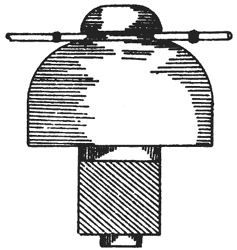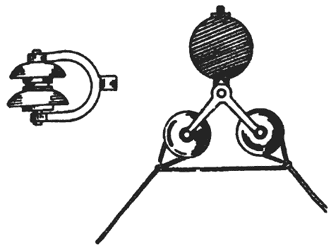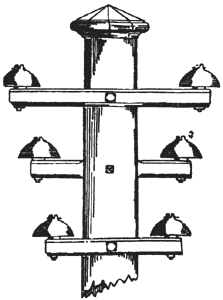[Trade Journal]
Publication: The Life Story of Sir Charles Tilston Bright
London, England
p. 11-12, col. 1
·
·
In 1852, the subject of this memoir, when scarcely twenty years of age, was asked by the Board to become their Engineer-in-Chief, which post he accepted, resigning his position on the "British." Edward Bright had been Manager of the Company for some months previously.
It was in this year that the brothers took out their famous patent, to which allusion has already been made. It contained twenty-four distinct inventions connected with telegraphs, and it may be well here to enumerate some of the more important.
First of all, there was the porcelain insulator for fixing aerial telegraph wires mounted on posts. This has been found to be a highly efficient method of insulation. (1) It was at once adopted on an extensive scale, and, in one form or another, it continues in use to the present day. There was also its adjunct, the shackle or terminal insulator. This is also made of porcelain, and is universally employed for terminations, and whenever the wire has to be taken at an angle—over houses, for instance, round a corner, or in any case where great strains are involved, whether owing to long spans or otherwise.
 |
| Bright's Insulator |
 |
| Bright's Shackle's |
 |
| Bright's Telegraph Post |
Then followed the now universal system of aeriel telegraph posts with varying length of arms, to avoid the chance of one wire dropping on another.
After this came the brass tape device for the protection of insulated conductors of subterranean, or submarine, cables.
There was then a translator, or repeater, for re-transmitting electric currents of either kind in both directions on a single wire.
Another important item in the above famous master patent was the plan of testing insulated conductors for purposes of fault localisation. This, however, has already been referred to.
There was also a standard galvanometer (foreshadowing differential testing) and a new type-printing instrument, as well as what was then a novel mode of laying underground wires in troughs.
This patent was taken out when the patentees were respectively twenty-one and twenty years of age; but it contained the results of four years' combined thought.
In addition to the labour and experiments associated with the practical application of these improvements for the "Magnetic" Company, during 1852, young Bright directed the completion of a vast telegraphic system throughout the United Kingdom, which had lately been commenced by the Company. This included a main trunk line along the high-roads, consisting of ten gutta-percha-covered wires laid in troughs underground between London, Birmingham and Manchester, thence by railway to Liverpool and Preston, and six wires onwards, also underground, to Carlisle, Dumfries, Glasgow, and Greenock. From Dumfries a branch of six underground wires was laid under the roads to Portpatrick, to meet the Company's Irish cable. In Ireland, the underground system was extended from Donaghadee to Belfast, and thence, via Newry and Dundalk, to Dublin, comprising in all nearly 7,000 miles of wire. Although gutta-percha had been discovered in 1843, and its insulating qualities had been appreciated by Faraday and Werner Siemens as early as 1847, this was the first instance, in our country, in which any length of gutta-percha-covered cable had been laid underground.
(1) In his article on the "Electric Telegraph," in the Encyclopedia Britannica, 8th edition, vol. xxi., the late Lord Kelvin referred to this as "the best idea, for a single telegraphic insulator."
·
·
